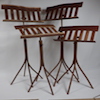Getting a jump on next year's holiday toy drives. I'm thinking of making a bunch of building block sets which would be painted in bright colors - red, green, blue, yellow. Probably a childsafe acrylic paint, but haven't really researched that part beyond finding that Rustoleum has such a product.
What I do want to figure out is how to paint a large number of blocks, say 5000 or more. I've tried several web searches hoping to find some insight into how this done commercially, but I found nothing beyond hand painting. I assume a commercial maker would spray or dip. I have questions of how blocks are held while being sprayed (or dipped) so as to not leave marks in the finish as it dries.
Would greatly appreciate any info or links someone could provide in this regard.
Thanks!






 Reply With Quote
Reply With Quote



 and the extremely small spot that the needle prevented paint should not be an issue at all.
and the extremely small spot that the needle prevented paint should not be an issue at all.

